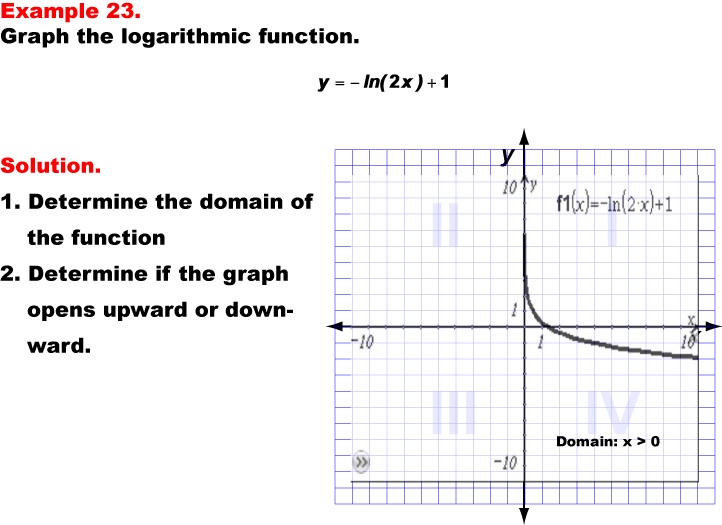
Display Title
Math Example: Graphs of Logarithmic Functions: Example 23
Display Title
Math Example: Graphs of Logarithmic Functions: Example 23

Topic
Logarithmic Functions
Description
This example illustrates the graph of the negative natural logarithmic function y = -ln(2x) + 1. The graph opens downward, curving from right to left, demonstrating how the combination of a negative sign, multiplication inside the logarithm, and addition outside affects the function's behavior. The domain of this function remains x > 0, as the expression inside the natural logarithm must be positive.
Natural logarithmic functions, including their negatives and transformations, are crucial in many scientific and mathematical applications, particularly in calculus and differential equations. They are often used to model complex decay processes and inverse exponential relationships in fields such as biology, physics, and economics. This collection of examples helps teach logarithmic functions by presenting a range of equations with different parameters, allowing students to visualize and understand how these changes impact the graph's shape, position, and range.
Exploring multiple worked-out examples is vital for students to develop a comprehensive understanding of logarithmic functions and their transformations. Each example builds upon previous knowledge, introducing new concepts and variations. This approach helps students recognize patterns, make connections between different forms of logarithmic equations, and develop problem-solving skills that can be applied to more complex scenarios involving exponential and logarithmic relationships.
Teacher's Script: Let's examine our twenty-third example, y = -ln(2x) + 1. How does this graph compare to the previous natural logarithm functions we've seen? Notice the significant change in the graph's direction. Can you explain why it opens downward now? Consider the effect of the negative sign outside the logarithm. The domain remains x > 0, but how has the range changed? Think about how the multiplication by 2 inside the logarithm and the addition of 1 outside affect the graph's position. Can you predict where this graph will intersect the y-axis?
For a complete collection of math examples related to Logarithmic Functions click on this link: Math Examples: Graphs of Logarithmic Functions Collection.
| Common Core Standards | CCSS.MATH.CONTENT.HSF.IF.C.7, CCSS.MATH.CONTENT.HSF.IF.C.8.B, CCSS.MATH.CONTENT.HSF.BF.B.5, CCSS.MATH.CONTENT.HSF.IF.C.7.E, CCSS.Math.CONTENT.HSF.LE.A.2, CCSS.MATH.CONTENT.HSF.LE.A.3, CCSS.MATH.CONTENT.HSF.LE.A.4, CCSS.MATH.CONTENT.HSF.LE.B.5 |
|---|---|
| Grade Range | 9 - 12 |
| Curriculum Nodes |
Algebra • Exponential and Logarithmic Functions • Graphs of Exponential and Logarithmic Functions |
| Copyright Year | 2013 |
| Keywords | logarithmic functions, graphs |